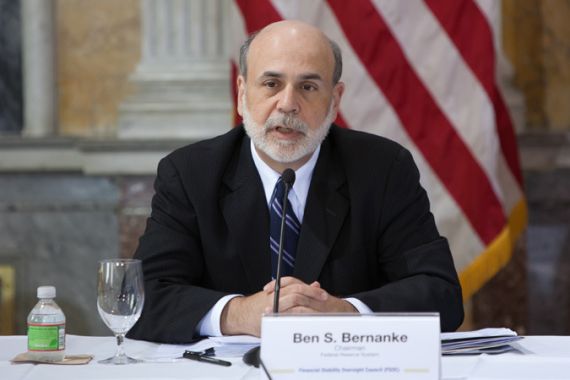US Fed unveils new stimulus package
Central bank to sink $600bn into government bonds in a plan it hopes will push interest rates even lower than they are.

Kimberly Halkett reports on how skepticism clouds the stimulus plan as anger grows over “excessive” spending.
The United States central bank has announced it will buy $600bn worth of government bonds over the next eight months in a bold plan it hopes will further lower interest rates and spark a chain reaction that will create jobs and boost the economy.
Keep reading
list of 4 itemsWhy are nations racing to buy weapons?
Parallel economy: How Russia is defying the West’s boycott
US House approves aid package worth billions for Ukraine, Israel
The Federal Reserve’s move was announced on Wednesday by the Federal Open Market Committee and is described by some observers as the last possible effort to boost the ailing economy.
The announcement was followed by a downturn in major US stock market indicators, with both the Dow Jones Industrial Average and Standard & Poor’s 500 Index dropped 0.29 per cent.
On the other hand, global stock markets rose as the value of the dollar fell.
The bank said it would buy assets at a rate of around $75bn a month. But the total amount of the new effort – known as “quantitative easing”, combined with the lack of a promise from the Fed to continue buying assets past the June 2011 end date – likely disappointed the markets.
Inflation fears
Quantitative easing essentially means that a central bank creates its own money in order to buy assets, such as government bonds. The price of the bonds rises, and the interest rate falls. More money enters the market, and banks are able to borrow and lend more cheaply.
Some worry the Fed action will do little to boost the economy because interest rates are already historically low. Others fear the bond purchases could drive inflation too high over the long term.
In its statement on Wednesday, the committee said that the pace of the US economic recovery remains slow. Although households are spending slightly more, that increase has been checked by “high unemployment, modest income growth, lower housing wealth, and tight credit”.
The committee said it will regularly review the pace and overall size of the security purchases and aim to keep the federal funds rate – the interest rate for inter-bank lending – at between zero and 0.25 per cent. The federal funds rate has hovered near zero since an economic crisis sparked by the popping of an enormous housing bubble hit in late 2008.
The committee voted 10-1 to approve the programme, with Thomas Hoenig, the president of the Federal Reserve Bank of Kansas City, the lone dissenter. Hoenig has now voted against the majority’s decisions for seven straight meetings.
‘Monetary accommodation’
Hoenig was concerned that the programme and “continued high level of monetary accommodation” will cause an increase in inflation, the statement said.
In 2009, the Fed bought around $1.7tn in mortgage and government bonds in an attempt to lift the country out of its recession.
Mark Zandi, the chief economist at Moody’s Analytics, told the Associated Press news agency that the Fed’s new $600bn purchase will not solve the United States’ problems.
The programme will keep the unemployment rate level at around 9.6 per cent – instead of allowing it to rise – and will prod the economy to grow at an annual rate of 2.7 per cent – rather than 2.4 per cent without the purchase.
But the Fed also runs the risk of appearing to be printing money to pay for the country’s problems, a dangerous move in a political enviroment where voters have just delivered Democrats a resounding defeat for pushing strong government action to solve an economic crisis but so far failing to generate new jobs.